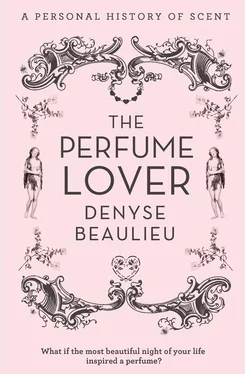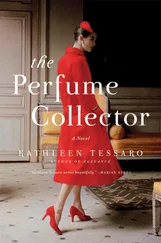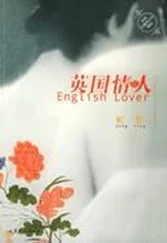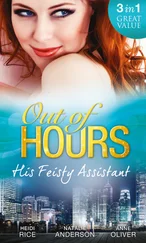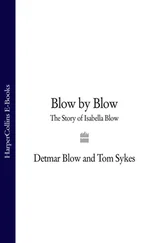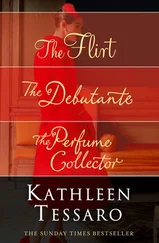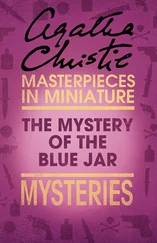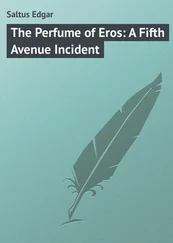Geneviève certainly meant well when she picked Max Factor’s Green Apple for me as a parting gift before she followed her husband to Saskatchewan. She must have been told it was suitable for young girls. I hated it. Unlike Rive Gauche, which had given me a glimpse of the woman I aspired to become, Green Apple didn’t tell a story. Or if it did, it was a story I didn’t want to hear in my first year in high school; a story that contradicted my training bra and the white elastic band that had already cut twice into my budding hips, holding up Kotex Soft Impression (‘Be a question. Be an answer. Be a beautiful story. But be sure.’) What it said was: ‘Don’t grow up.’
Wear Green Apple: He’ll bite, insinuated the Max Factor ad. Never mind that apple candy has never registered as a powerful male attractant and that I’d never been kissed by a ‘he’, much less bitten. I’d attended Sister Aline’s catechism class and I got the Garden of Eden reference behind that slogan, thank you. But to me, that bottle wasn’t the fruit of the Tree of Knowledge. It was Snow White’s poison apple. And an unripe one at that, just like me. The only apple-shaped things I wanted to own were starting to fill my A-cups.
When the good people at Max Factor put out their apple-shaped bottle, conjuring memories of Original Sin and of the Brother Grimms’ oedipal coming-of-age tale, they tapped into a symbolic association which Dior would later fully exploit with another potion in an apple. But that one would be called Poison: the myth of the femme fatale poured into amethyst glass and wrapped in a moiré emerald box – purple and green themselves hinting at venom and witchcraft …
When it was launched in 1985, I’d long grown out of my Green Apple trauma and into the twin addictions of ink (usually purple) and perfume. I hoped to become a writer, and a fragrant one at that. I’d just finished writing my Masters dissertation on 18th century literature and I was struggling through my first academic publication in France, an essay on Flaubert’s Madame Bovary, when I stumbled on an article about Poison, ‘a spicy perfume blending Malaysian pepper, ambergris, orange blossom honey and wild berries’. This was particularly serendipitous: the whole point of my essay was that the adulterous Emma Bovary’s aspiration to become a romantic heroine despite the mediocrity of her provincial surroundings was the result of her mind being poisoned by cheap romantic novels. A farmer’s daughter married off to a small-town doctor, she grew so frustrated at not being able to live out her girlhood fantasies that ‘she wanted to die. And she wanted to live in Paris.’ Emma never got closer to Paris than Rouen but she managed to run up such a debt with the local frippery pedlar that her house and belongings had to be auctioned off, whereupon she poisoned herself with arsenic. In my essay, I contended that the ink she had absorbed when reading romances had poisoned her every bit as much as the rat-killer.
‘What I blame [women] for especially is their need for poetization,’ Flaubert wrote in 1852 to his lover Louise Colet. ‘Their common disease is to ask oranges from apple trees … They mistake their ass for their heart and think the moon was made to light their boudoir.’ As neat a forecast as ever was of what would drive perfume advertising one century hence. Weren’t we all modern embodiments of Emma Bovary, I thought, seeking magic potions to transform our lives? To die or live in Paris … And now, a legendary couture house where a latter-day Bovary could well burn through her husband’s earnings was selling an intoxicating – and perhaps toxic – dream of romance and glamour under the slogan ‘Poison is my Potion.’
When the CEO of Christian Dior Parfums, Maurice Roger, first decided, in 1982, to launch Poison, the industry had been undergoing deep mutations. Perfume houses were being bought up by multinational companies, and their new products had to have global appeal. With the blockbusting, take-no-prisoners Giorgio Beverly Hills, America was starting to bite into a market that had hitherto been dominated by France. To make itself heard around the world in the brash, loud, money-driven 80s, the house of Dior had to create a shock. This, Maurice Roger knew, meant renouncing the variations on the name ‘Dior’ which had been used to christen all their feminine fragrances from the 1947 Miss Dior to the 1979 Dioressence; it meant foregoing Parisian ‘good taste’ and striking with an unprecedentedly powerful scent and concept. It meant re-injecting magic, mystery and a touch of evil into something that was no longer for ‘special moments’ (think of that fragrance your grandmother kept on her dressing table and only dabbed on when she pulled out the mink and pearls), no longer a scent to which women were wedded for life, but a consumer product. The magic, this time, would be entirely marketing-driven, though the fragrance itself, selected out of eight hundred initial proposals, required over seven hundred modifications before reaching its final form.
The promotional campaign kicked off with a ‘Poison Ball’ for 800 guests at the castle of Vaux-le-Vicomte hosted by the French film star Isabelle Adjani. And, if the bottle was reminiscent of the story of Snow White, the advertising film conjured another fairy tale, The Beauty and the Beast. Its director, Claude Chabrol, never hinted that the would-be femme fatale might be the one to succumb, Bovary-style, to the potion it touted. But I’m sure Chabrol, who would go on to direct an adaptation of Madame Bovary, had a thought for one of his film heroines, the eponymous and fragrantly named Violette Nozière, a young prostitute found guilty of poisoning her parents in 1934 (both characters played by the exquisitely venomous Isabelle Huppert).
‘Who would offer someone a gift of poison?’ the New York Times fashion editor wailed. And Dior’s blockbuster did, in fact, wreak havoc in its wake. Innocent bystanders complained of headaches and dizziness; diners were put off their food by its near-toxic intensity. It was banned in some American restaurants, where signs read ‘No Smoking. No Poison.’
Perfume is an ambiguous object, forever hovering on the edge of stink: what smells suave to me can be noxious to you, and the padded-shouldered juices of the 80s gave the first ammunition to the anti-perfume movement. Google ‘perfume + poison’ today and you’re just as likely to find entries about Dior as exposés on the purported toxicity of fragrance. Perfume aversion is no longer fuelled by the strength of the smell of perfume but by fear of the invisible chemicals that might be infiltrating our bodies through our skin and lungs. Activist groups have been flooding the internet with ominous warnings about ‘unlisted ingredients’ which sound as if they belong in some mad scientist’s lethal cocktail and would be enough to put off anyone but the staunchest fragrance aficionado. And since perfume, unlike anthrax, radiation, or the toxins in building materials, food and water, is both perceptible and dispensable, it’s crystallized a rampant paranoia. If you start obsessing that the woman in the next cubicle is poisoning you with her Obsession, at least you can do something about it: file a lawsuit.
But the fear of smells itself, brilliantly explored by the French historian Alain Corbin in his 1982 classic The Foul and the Fragrant, goes back millennia. Until the link between germs and disease was established in the late 19th century, people were convinced smells could kill. As far back as the 5th century AD, physicians were accusing foul odours of causing plagues. Since nobody knew how illnesses spread, it seemed logical to suspect the airborne stench rising from graveyards, charnels, open cesspools or stinky swamps. And no less logical to suppose that the stench, and hence the disease it carried, could be repelled by another, stronger smell. Aromatic materials were not only considered salubrious because of their medicinal properties: they were also believed to be the very opposite of the corruptible animal and vegetal matters whose putrescence was thought to cause disease. In fact, they were just about as pure as earthly matter could be, since aromatic resins burned without residue, and essential oils were the volatile spirit that remained after the distillation of plants. Those very same aromatic materials were used to prevent corpses from putrefying. Could they not prevent the corruption of the living body by disease as well?
Читать дальше
